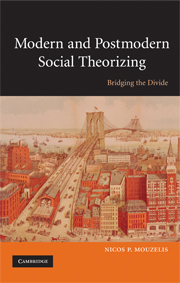Book contents
- Frontmatter
- Contents
- List of figures
- Acknowledgements
- Introduction
- Part I The theoretical background: the development of the agency–structure problematic
- Part II Parsonian and post-Parsonian developments
- Part III Agency and structure: reworking some basic conceptual tools
- 6 Social and system integration: Lockwood, Habermas and Giddens
- 7 The subjectivist–objectivist divide: against transcendence
- 8 Habitus and reflexivity: restructuring Bourdieu's theory of practice
- Part IV Bridges between modern and late/postmodern theorizing
- Part V Towards a non-essentialist holism
- Instead of Conclusion: Twelve rules for the construction of an open-ended holistic paradigm
- Appendix: In defence of ‘grand’ historical sociology
- References
- Index
6 - Social and system integration: Lockwood, Habermas and Giddens
Published online by Cambridge University Press: 05 June 2012
- Frontmatter
- Contents
- List of figures
- Acknowledgements
- Introduction
- Part I The theoretical background: the development of the agency–structure problematic
- Part II Parsonian and post-Parsonian developments
- Part III Agency and structure: reworking some basic conceptual tools
- 6 Social and system integration: Lockwood, Habermas and Giddens
- 7 The subjectivist–objectivist divide: against transcendence
- 8 Habitus and reflexivity: restructuring Bourdieu's theory of practice
- Part IV Bridges between modern and late/postmodern theorizing
- Part V Towards a non-essentialist holism
- Instead of Conclusion: Twelve rules for the construction of an open-ended holistic paradigm
- Appendix: In defence of ‘grand’ historical sociology
- References
- Index
Summary
The distinction between social integration and system integration has been a useful tool in the empirical investigation of social transformation. The various attempts to change or transcend this well-known dichotomy relate it to some key debates in sociological theory, such as the status of functionalist explanations, the links between subjectivist and objectivist sociologies, the issue of essentialist accounts of social phenomena, etc. In the present chapter I focus on how Habermas and Giddens have tried to restructure Lockwood's distinction, and argue that their attempts have not been very successful and that it is more useful to retain Lockwood's original formulation (with some modifications).
Lockwood
For Lockwood (1964), the distinction between social integration and system integration sensitizes the student to two different ways of viewing social wholes; in turn, these two different perspectives lead to different mechanisms accounting for social order or disorder. Social integration refers to ‘the orderly or conflictual relationships between the actors’, whereas system integration focuses on the compatible or incompatible/contradictory relationships between ‘the parts of the social system’ (1964: 244).
Looking at a social whole from the point of view of actors and their relationships leads to investigating the problem of social order/disorder in terms of social co-operation/conflict. These are the result of the actors – on the basis of how they conceive the social world – developing strategies for defending or promoting what they consider to be their interests. On the level of system integration, the focus shifts from an agency to a systemic perspective.
- Type
- Chapter
- Information
- Modern and Postmodern Social TheorizingBridging the Divide, pp. 97 - 106Publisher: Cambridge University PressPrint publication year: 2008
- 1
- Cited by



